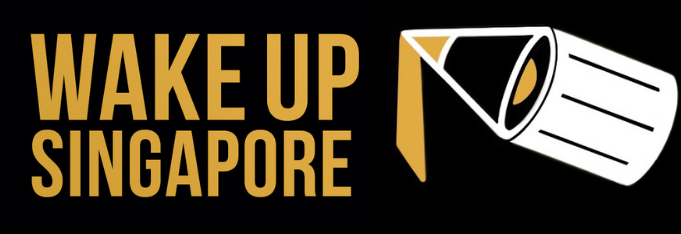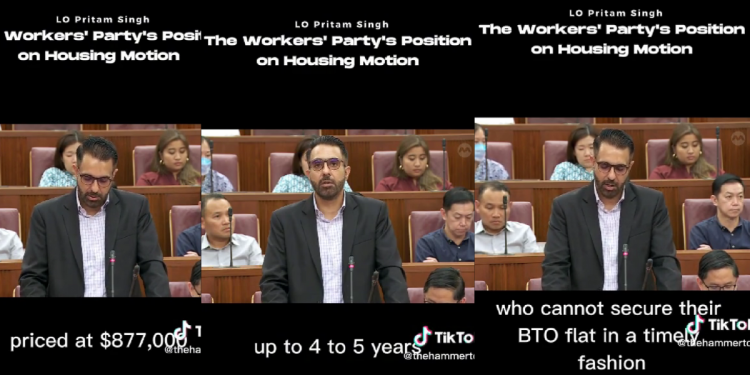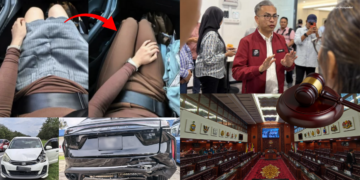At the tail-end of a 2-day long debate, the Leader of the Opposition, Pritam Singh delivered a well-researched speech that is worth reading in its entirety. Following the speech, in a powerful show of Opposition solidarity, Mr Singh announced that the Workers’ Party will vote in favour of the Progress Singapore Party’s Motion.
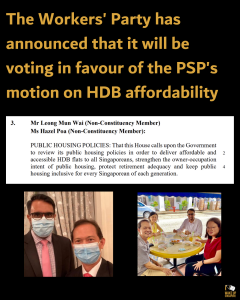
All 9 Workers Party MPs and the 2 PSP NCMPs voted in favour of PSP’s motion, and against the PAP’s motion.
Introduction
Mr Speaker, the Workers’ Party MPs have spoken on a number of relevant areas and shared our views on the motions before the House. Sengkang GRC MP Louis Chua Kheng Wee has spoken about the inadequacy of Build-to-Order HDB (BTO) launches, Sengkang GRC MP A/P Jamus Lim has spoken about the tension between housing as an asset and retirement solution, Aljunied GRC MP Leon Perera has proposed building ahead of demand and the prospect of 70-year leases to build up CPF retirement funds and Aljunied GRC MP Gerald Giam has spoken of how to arrest resale prices.
As for my speech, it is in four parts. First, I will touch on how housing policy has evolved in the past. Second, I will discuss where we stand on both affordability and accessibility of HDB flats. Third, I will make some queries on how land is priced. Finally, I will ask the Minister some questions on public housing taxpayer subsidies.
Public Housing Policy in the past
Let me start with a look at public housing policy in the past.
In 1964, the Government introduced the Home Ownership for the People Scheme so that Singaporeans would own rather than rent their flats. It was intended that through home ownership, Singaporeans would have a tangible stake in Singapore’s success. The policy then was that flats would only be sold to families earning less than $800 a month. The Home Ownership for People Scheme did not really take off at the beginning as not many people could afford the 20% downpayment in cash to secure a flat. This changed dramatically some four years later in 1968 when CPF funds were made available to pay for public housing.
In 1971, there was a significant shake-up in public housing when the Government allowed HDB flats to be resold for a profit, although not for investment. This created the HDB resale market.
In 1973, an amendment to the Land Acquisition Act allowed the Government to purchase land from owners at prices independent of the land’s purchase price or prevailing market rates. This allowed the Government to purchase a great deal of land at low prices.
This historical fact accounts for the ever so often heard view that because the HDB bought the land cheaply and since that land would be returned to the HDB after 99 years, there is scope for the State to take a different, more enlightened view about land costs in order to make public housing more affordable and consider other approaches beyond strict market pricing to keep HDB flats affordable.
In the 70s, 80s and 90s, property prices in Singapore kept rising. Lease decay did not factor heavily in the public consciousness as many flats were relatively new. However, a serious correction to housing prices hit hard on the back of the Asian Financial Crisis.
After the 2001 elections, then Prime Minister Goh promised a review of costs. Much was expected of the Economic Review Committee, in particular the Land Working Group. Then, land costs came into the gunsights of those worrying about the cost of doing business in Singapore and the cost of housing. Instead of precipitating bold changes, the Land Working Group took the view that it was tough to demolish and rebuild Singapore’s land policy. The group’s report restated the constraints policy-makers faced, while advocating a greater role to be played by the private sector in the provision of public housing, and even suggesting the extension of grants for private home buyers.
As a country, we have been at the current property cycle before. Most recently, slightly more than a decade ago, when the prices of HDB flats increased rapidly after the Global Financial Crisis. To deal with that, the then Minister of National Development, Mr Khaw Boon Wan, announced the policy decision to delink HDB prices from resale prices.
However, much less was broadcasted about the fact that the increased subsidies to make flats affordable would be paid by taxpayers. This is significant. Because a large part of the Government solution whenever HDB prices went out of hand would be to resort to deploying more taxpayer’s monies, ostensibly in greater quantums, to make up the difference.
A significant overlay to the property cycles over the last few decades has been the public expectation that HDB flats would be ever-appreciating assets. This incorrect expectation was created, perpetuated, and not corrected by previous PAP governments.
A more responsible narrative would have informed the public that capital gains would be possible only in the short to medium term. It should have been made clear to all that quite simply, public housing on a 99-year lease cannot be expected to appreciate endlessly.
A few years ago, then National Development Minister Lawrence Wong finally spoke the unvarnished truth about 99-year leases – that flats would be returned to the HDB and only a small percentage of flats would undergo the Selective En-Bloc Redevelopment Scheme (SERS).
There was a highly negative public reaction to this clarification. One academic at the Lee Kuan Yew School of Public Policy put it this way: “The government hasn’t been entirely consistent in their messaging with regards to housing policy, which created the uncertainty and anxiety.” Unquote. Singaporeans felt there was a reneging of what they perceived as an asset appreciation promise by the PAP.
Where we are now
I now move on to the second part of my speech – where we are now?
Property prices in Singapore have soared in the last couple of years. As far as HDB flats are concerned, resale prices are breaking new records.
Rising property prices despite interest rate rises
Singapore is unique. In most parts of the developed world, property prices are moderating or falling because of rising interest rates. Since the US Fed started raising rates in March 2022, the situation in other countries has developed in the normal way. When interest rates rise, property transactions decrease and prices drop.
In Sinapore, despite steeply rising interest rates for nearly a year now, prices have shot sky-high. This is not normal. It is only because of new cooling measures that the property market shows signs of moderating. The fact of Singapore’s property prices going in a different direction from many other countries provides some proof that external circumstances are not the cause.
Sir, housing prices are essentially a matter of supply and demand. As far as property in Singapore is concerned, the Singapore government controls the supply of new property in the market, both in the public and private sectors. The Singapore government also controls the number of new citizens, PRs and has full information on birth rates. It controls the inflow of work and employment pass holders. The Government knows the application rates for HDB flats and controls HDB allocation. The Government is the largest land owner and developer of land, and is the regulator of land policy. Because of a preponderance of control over land supply, the Government is in the best position to ensures housing prices remain affordable and stable.
The levers at the disposal of the Government do not just include introducing cooling measures overnight by way of fiat. They include building public housing ahead of demand and stepping up private land sales to meet demand at reasonable prices. The fact is that the prices of HDB BTO flats, resale flats and private condominium prices generally move in sync.
Are HDB flats affordable and accessible?
Which brings me to today’s motions. The different phrasings of today’s two motions indicate the different thrust of each. The government’s motion implies that HDB flats have been kept affordable and accessible while the PSP’s motion seems to suggest that flats are now not affordable and accessible.
Some of the difference could be due to a different understanding of what each word means.
I would argue that affordable HDB flats mean HDB flat pricing that are not out of synchrony with salaries. For example, the rise in resale flat prices should not be perceived to outstrip salary increases. Resale prices have increased because people need homes and the HDB did not build enough BTOs to meet demand, which should have been known and calculable, notwithstanding COVID-19 related delays.
Over the last five years, the prices of larger resale flats, specifically five-room and executive flats have risen even faster than 4-room resale flats. Million-dollar HDB flats no longer make the news. Such sales take place even in areas such as Woodlands, heightening the anxieties of parents and young families and adults with regard to the affordability.
While the House Price to Annual Income or (HPI) is a common gauge to appreciate the affordability of HDB flats, in the Singapore context, it is the taxpayer subsidy or what the Government refers to as “generous subsidies” that is keeping the number in check. In all likelihood, either these subsidies will grow ever larger to keep HDB flats affordable, or more subsidies will have to be recouped at the point of sale, similar to how it is done for Prime Location Public Housing (PLH) flats currently. This would be a somewhat analogous, albeit different situation to the PSP’s proposal for deferred land costs by way of its Affordable Housing Scheme. In one situation – in this case, PLH flats – a designated portion taxpayer subsidies are returned to the Consolidated Fund, and in the other, land costs will be returned into the Past Reserves.
The Government regularly trots out that the HDB housing backlog after the Asian Financial Crisis as a reason for not wanting to build excessively. However, this sacred cow is one that needs to be slaughtered, particularly because of the serious implications an overheated housing market has on public housing prices for the common man and woman. Clearly, the current orthodoxy is one that feeds itself. If the Government does not release adequate parcels of land quickly enough, a bubble can rapidly form, one that has a direct implication on HDB BTO, resale prices and the prospect of an increase in taxes to fund subsidies.
What about the word “accessible”? Accessibility includes not just being able to apply for and book a flat. It also means securing a flat in a timely way. Today, waiting times can stretch up to four to five years for BTO flats. When people get their flats later, they may also put off having children earlier, a largely perverse policy outcome in the face of our efforts to encourage young couples to form families and have children. The decision to build-to-order rather than ahead of demand has likely had an impact on the reproductive rates of Singaporeans. It should not come as a surprise if couples and newer generations of Singaporeans want to occupy their own home before starting a family, and having children.
Let me share a newspaper article with an approach to accessibility that needs to be reviewed. This is will address accessibility in a meaningful way. The multi-page advertisement from HDB in the Straits Times is dated 3 July 1989. I quote:
Under the booking system, HDB will announce every quarter, the building contracts it has awarded. The number of units of each type of flat, their location, layout and design and the price range for each type of flat in each location as well as the expected date of completion will also be made known.
HDB will simultaneously release broad plans of the building contracts for the subsequent 9 months. The number and types of flat and their locations will also be made known. The details provided in these broad plans may change depending on the demand for flats in the area. Thus HDB will, in effect, announce a rolling 12-month building programme every 3 months. It will do the same at the start of every quarter…An applicant who has booked a flat will normally take possession of his flat in about 2 and a half years after booking. (Unquote)
Today, the BTO system is both similar and different to the Booking System of 1989 in some respects, but one fact is dramatically different. The BTO system today does not promise flats for buyers in two and a half years.
Of course, the downside of this pre-BTO model which ensured an ample supply of flats, is that in the event of a black swan episode like the Asian Financial Crisis, there may well be an excess stock of flats which take time to clear. But in that worst case scenario, new accessibility options can be considered. For example, HDB would be able to offer excess flats towards schemes like the Parenthood Provisional Housing Scheme (PPHS) which is oversubscribed even today. Other options include expanding rental options for low-income households which host large families to flat types that can be up to 3-room or even 4-room in size.
I acknowledge the reply given by Minister Desmond Lee to Sengkang GRC MP Louis Chua Kheng Wee by way of parliamentary question that since 2018, the HDB has offered close to 11,000 BTO flats with Shorter Waiting Times (SWT) of less than three years. However, as the Minister revealed, for the 23,184 flats launched in 2022, only 8% are shorter wait BTO flats. The Minister’s new commitment as announced yesterday to increase this by 2000 to 3000 flats will not move the 2022 figure of 8% in a significant way.
How is it that HDB could build high quality flats at a much faster rate decades ago compared to today even after the introduction of productivity measures such as prefabrication technology. Can the Minister make a commitment to bring accessibility to commitments made in 1989?
Where do we go from here
Mr Speaker, it is trite to say that any major reset of public housing policy cannot take place without upsetting either buyers or sellers, or perhaps both. The Government currently set land costs at fair market value to the prices of flats. Mr Leong Mun Wai has sought to address the land costs component of HDB flat prices from a new perspective through the PSP Affordable Homes Scheme proposal. The Government would be familiar with the gist of this proposal as it was originally put forward by a researcher from the Institute of Policy Studies – a government think-tank – almost a decade ago.
Land Costs
The idea of the land costs for public housing being accounted for differently is not new. There have been calls from the public and in the mainstream media to see how land costs can be dealt with to make HDB prices more affordable.
In 2002, the Business Times published a reader’s letter which said, and I quote: “Land is purchased and assigned to HDB by the Singapore Land Authority. The actual land cost on the assignment to HDB should not be governed by the market, as the role of HDB must include the important social objective to provide public housing to those who are unable to participate in the private sector. This is a fundamental policy issue which needs to be acknowledged. We need to be more transparent regarding the cost of land assignment so that the public can constructively and actively participate in examining the formula of land assignment to HDB.” Unquote.
In 2013, on the back of the Our Singapore Conversation, a Straits Times editorial titled “Pondering next phase of public housing” stated, “When the HDB’s key mission of building affordable homes has to go hand in hand with broader considerations, a variety of fresh ideas deserve to be explored. Those floated by National Development Minister Khaw Boon Wan recently are lower-priced Build-to-Order flats with a longer minimum occupation period before these can be sold on the open market, a shorter lease to match cheaper prices, and the separation of new flats from others by allowing resale only to the HDB. Other means of lowering prices could be to increase grants to first-timers or to take land costs out of prices and recover this when the flat is resold.” Unquote.
In a POFMA clarification of 14 Oct 2022 directed at Yeoh Lam Keong by the Ministry of National Development, the Government stated that it cannot sell State land at nominal or at a much lower cost than its fair market value without the President’s approval, as doing so would constitute a draw on Past Reserves.
On this point, I have some questions for the Minister.
Can the Minister confirm if the words I quote, “not much lower cost than its fair market value” unquote as stated in the POFMA direction, suggest that land for HDB flats can be sold to the HDB at a price lower than its market value as established by the Chief Valuer? If so, under what circumstances can this be done?
In comparison, such an interpretation would not be inconsistent with the concept of a Reserve Price for sites sold under the Government Land Sales (“GLS”) for private housing and Industrial GLS programmes which are pegged to 85% of the estimated market valuation of each site. Tenderers will qualify if they bid more than 85% of the assessed market value of the land. If they bid less than up to 85%, the tender exercise is aborted.
Does the up to 15% discount on the market price of land or the reserve price under GLS programmes constitute a draw on Past Reserves, and would the President’s approval be required for such land sales which are sold below market valuation and if not, why not? Finally, how did the Government decide on accepting tenders for private land at 15% below the market value, and what is the basis to this figure of 15%?
Based on a recent Parliamentary Question by Sengkang GRC MP Louis Chua Kheng Wee, we also know that the Government does not automatically rule out bids below the Reserve Price for GLS sites, and that the award of a site depends on the prevailing market conditions, number of independent bids received, and the specific circumstances of each site.
I would like to ask the Minister, how do these exceptions avoid the often heard PAP criticism of raiding past reserves? Would such exceptions provide enough reason and context to review how the Government prices land for public housing with a view to gradually cool the market? Conceptually, this would not be dissimilar to the fiat the Government can wield in not ruling out tender bids below the reserve price for private land.
Questions for the Minister on subsidies
I come to the final section of my speech with questions for the Minister on subsidies.
Sir, the quantum of subsidies the HDB allocates for the Home Ownership scheme is another important but less ventilated aspect of HDB policy when it comes to affordability. These are taxpayer subsidies and they represent the “loss” that the HDB incurs on the HDB’s Home Ownership Programme. This loss is fully-funded and made good by the taxpayer.
In his oral reply to my supplementary question last month, Minister said that resale prices had increased to around 28 or 29% over the last few years but that BTO prices had been kept stable ostensibly because taxpayer subsidies made up for the difference. It must follow that government expenditure would be reallocated or directed from some other programs to the fund the home ownership program. This fact alone, one that has significant fiscal implications – but also a fact the Government to my knowledge has thus far never canvassed as a reason to raise taxes – would make it important for the Government to provide a breakdown of the dollar value of taxpayer subsidies for the Home Ownership Programme.
The broad answer given to my Parliamentary question on a breakdown of taxpayer subsidies filed last month was that the taxpayer subsidies are not the same across BTO developments. This reply raises important questions of fairness and equity. Mature BTO flats are more highly sought after compared to non-mature flats precisely because there is usually a greater profit and upside to be made after the Minimum Occupation Period (MOP), bringing the question of subsidies into acute focus.
Mr Speaker, I speak without benefit of the information I sought in my Parliamentary question. Based on the Minister’s reply, it would appear that an applicant who succeeds in applying for a BTO flat in a mature estate where flats can be significantly more expensive, benefits from more taxpayer subsidies than one who secures a BTO flat in a non-mature estate. With respect to these taxpayer subsidies, a distinction between mature and non-mature BTO flats is important because any deployment and subsequent recovery of subsidies for the Home Ownership Programme ought to be equitable and progressive.
To this end, different subsidies allocated for different HDB BTO developments did not prevent former Minister for National Development Khaw Boon Wan from sharing the dollar value of subsidies for specific BTO developments. On the 9th of September 2012, in a written answer to a question by MP Ellen Lee, even without being specifically asked, the Minister shared the example of Waterway Banks, a BTO project launched in November 2011 in Punggol. The then Minister shared that this project had 1016 units of 2 to 4-room flats. The project cost was $279 million, and sales proceeds amounted to $240 million with taxpayer subsidies making up $39 million. The then Minister’s answer starkly makes the point that there is actually no reason that can adequately explain why the current Government does not release the information on the taxpayer subsidies allocated for each BTO development.
Coming back to Mr Khaw’s revelation of subsidies for the Waterway Banks project, will the Minister confirm if taxpayer subsidies to make up the difference between the sales proceeds and project costs are applied equally, regardless if a buyer purchased a two-room or four-room flat for example, or is the subsidy tiered proportionally to flat sizes?
Compounding the matter of limited transparency on subsidies further, is the application of the resale levy at the point of sale. The policy intent of the resale levy is to reduce the taxpayer subsidy that a buyer receives on their second subsidised HDB BTO flat and ensures a fairer distribution of subsidies between first and second timers. At the point of sale of their first subsidised flat, the first-time buyers of both a mature and non-mature BTO flat must return some portion of the taxpayer subsidies through the resale levy.
Can the Minister clarify, for individuals who bought a BTO flat after 3 Mar 2006, what is the range of subsidies a 4-room mature and non-mature BTO flat lessee respectively would have received, even though the actual resale levy is fixed for both lessees at $40,000 by HDB? Until the Minister releases more information, it is open to question if the payment of the resale levy – which crucially does not distinguish between mature and non-mature flats – is either fair or equitable, in view of the potentially wide variation between the original subsidies allocated to either lessee upon their first BTO purchase. I hope this information is forthcoming so alternative pricing models for HDB flats, a fairer allocation of taxpayer subsidies and new policy proposals can be considered and advanced.
Conclusion
In conclusion Mr Speaker, the PAP motion as drafted does not sufficiently take into account the reality that the Government should endeavour to make HDB BTO flats more affordable and accessible than they currently are.
The Workers’ Party proposes an amendment to the motion in the name of the Minister for National Development:
The single amendment is as follows:
In line 3, to delete “endorses the commitment of the Government to” and insert “calls on the Government to intensify its efforts to meet”
Sir, I seek your permission to move the amendment. May I hand over a copy of the amendment to you before seeking your approval to circulate it to members?
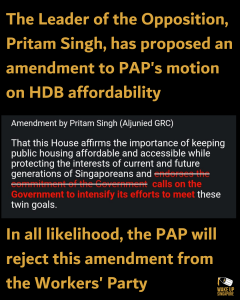
I ask Members to consider whether the current anxieties of Singaporeans do not warrant greater effort by the PAP Government to review its commitment to affordability and accessibility with respect to public housing.
Voting for the PAP motion as drafted would mean Singaporeans are satisfied with waiting up to four to five years for a HDB BTO flat. It would also mean that Singaporeans do not have any quarrel with the price of some BTO flats such as five-room BTOs in Ang Mo Kio priced at $877,000 and the significant increase in resale flat prices across the board. It would also mean that young couples and first-time Singaporean families who cannot secure a HDB BTO flat in a timely fashion and are pushed into the resale market where resale prices are higher than they have ever been – are not seeking better outcomes from public housing policies.
@thehammertok Are you satisfied with the current outcomes of our Public Housing policies? Let us know in comments. #wpsg #workerspartysg #sgparliament #HDB
♬ original sound – The Workers’ Party 🔨 – The Workers’ Party 🔨
We know from our engagement with Singaporeans this is far from the case.
In the circumstances, it would be thoroughly underwhelming and missing the point for this House to carry a motion which endorses the commitment of the Government’s efforts on affordability and accessibility thus far.
Amending the motion to call on the Government to intensify its efforts to make HDB flats more affordable and accessible would be consistent with the reasonable expectations that Singaporeans have for public housing today.
For the record, we have no fundamental objection to the PSP motion. One PAP member inferred the PSP motion to be insidious. The Workers’ Party does not share that view. We do not read any implication into it but as a call on the Government to review its public housing policies with a view towards greater affordability and accessibility. This is something the Government does regularly in response to feedback. For example, at the last Committee of Supply debates, on HDB priority schemes, the Workers’ Party called on the Government to increase the ballot opportunities for first timer married couples with children to secure flats. Some time later, the Government announced changes broadly along these lines.
On their specific proposals which are separate from the wording of the motion, we believe a deep conversation of the options surrounding land pricing policy and how land for public use is valued should be a priority the Government to ensure HDB flats can be more affordable and accessible particularly in the face of more taxpayer subsidies to fund the HDB Ownership Programme.
Thank you Mr Speaker.
More from Wake Up Singapore
Since you have made it to the end of the article, follow Wake Up Singapore on Telegram!
